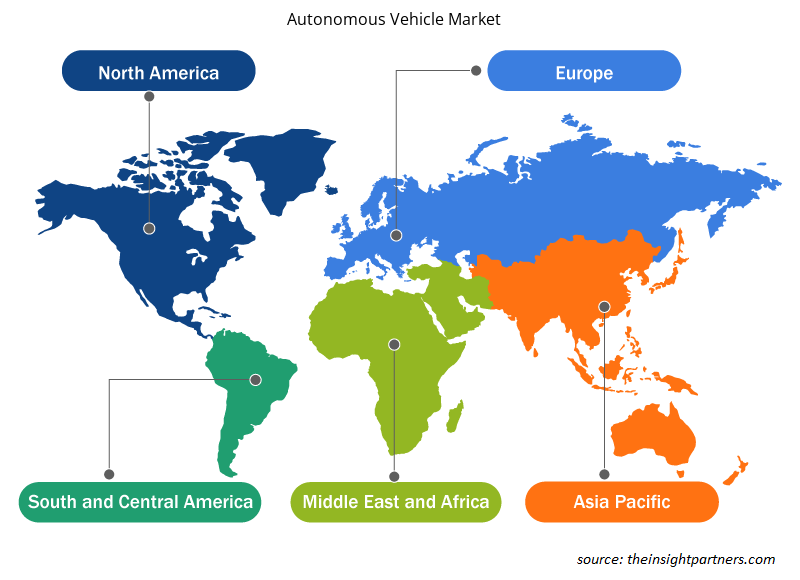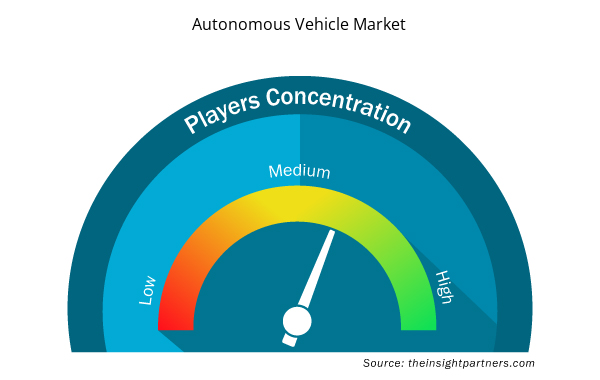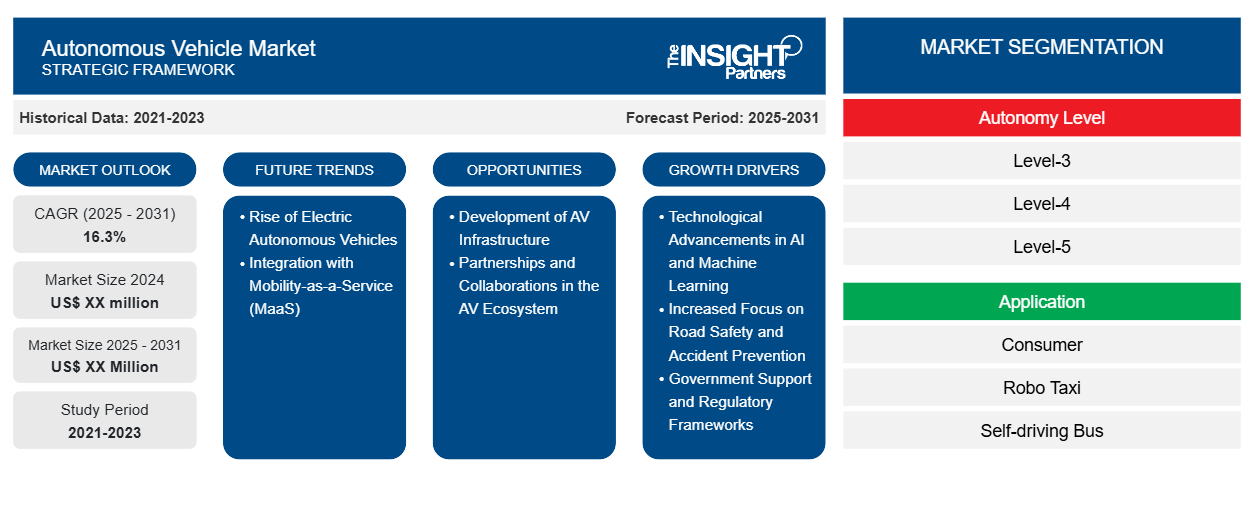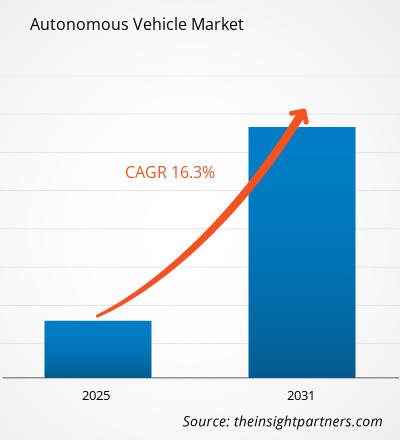Es wird erwartet, dass der Markt für autonome Fahrzeuge von 2023 bis 2031 eine durchschnittliche jährliche Wachstumsrate (CAGR) von 16,3 % verzeichnet, wobei die Marktgröße von XX Millionen US-Dollar im Jahr 2023 auf XX Millionen US-Dollar im Jahr 2031 anwachsen wird.
Der Bericht ist segmentiert nach Autonomiestufe (Stufe 3, Stufe 4, Stufe 5); Anwendung (Verbraucher, Robo-Taxi, selbstfahrender Bus, Ride Hail, Ride Share). Die globale Analyse ist weiter auf regionaler Ebene und nach wichtigen Ländern aufgeschlüsselt. Der Bericht bietet den Wert in USD für die oben genannte Analyse und Segmente.
Zweck des Berichts
Der Bericht „Autonomous Vehicle Market“ von The Insight Partners zielt darauf ab, die aktuelle Landschaft und das zukünftige Wachstum sowie die wichtigsten Antriebsfaktoren, Herausforderungen und Chancen zu beschreiben. Dies wird verschiedenen Geschäftspartnern Einblicke geben, wie zum Beispiel:
- Technologieanbieter/-hersteller: Um die sich entwickelnde Marktdynamik zu verstehen und die potenziellen Wachstumschancen zu kennen, damit sie fundierte strategische Entscheidungen treffen können.
- Investoren: Durchführung einer umfassenden Trendanalyse hinsichtlich der Marktwachstumsrate, der finanziellen Marktprognosen und der Chancen entlang der Wertschöpfungskette.
- Regulierungsbehörden: Sie regulieren Richtlinien und polizeiliche Maßnahmen auf dem Markt mit dem Ziel, Missbrauch zu minimieren, das Vertrauen der Anleger zu bewahren und die Integrität und Stabilität des Marktes aufrechtzuerhalten.
Marktsegmentierung für autonome Fahrzeuge
Autonomiestufe
- Stufe 3
- Stufe 4
- Stufe 5
Anwendung
- Verbraucher
- Roboter-Taxi
- Selbstfahrender Bus
- Ride Hail
- Mitfahrgelegenheit
Passen Sie diesen Bericht Ihren Anforderungen an
Sie erhalten kostenlose Anpassungen an jedem Bericht, einschließlich Teilen dieses Berichts oder einer Analyse auf Länderebene, eines Excel-Datenpakets sowie tolle Angebote und Rabatte für Start-ups und Universitäten.
- Holen Sie sich die wichtigsten Markttrends aus diesem Bericht.Dieses KOSTENLOSE Beispiel umfasst eine Datenanalyse von Markttrends bis hin zu Schätzungen und Prognosen.
Wachstumstreiber für den Markt für autonome Fahrzeuge
- Technologische Fortschritte bei KI und maschinellem Lernen: Der kontinuierliche Fortschritt bei KI- und maschinellen Lerntechnologien treibt den Markt für autonome Fahrzeuge (AV) an. Diese Fortschritte ermöglichen es AVs, Daten von Sensoren besser zu verarbeiten, Entscheidungen in Echtzeit zu treffen und die Sicherheit zu erhöhen. KI ermöglicht es Fahrzeugen, ihre Umgebung immer genauer zu interpretieren, was die Navigation, Kollisionsvermeidung und das Verkehrsmanagement verbessert. Mit der Weiterentwicklung dieser Technologien steigt die Zuverlässigkeit selbstfahrender Autos, was zu größerem Vertrauen und größerer Akzeptanz bei den Verbrauchern führt, was das Wachstum des Marktes beschleunigt.
- Verstärkter Fokus auf Verkehrssicherheit und Unfallverhütung: Autonome Fahrzeuge sind in der Lage, menschliche Fehler zu reduzieren, die für die Mehrheit der Verkehrsunfälle verantwortlich sind. Durch den Einsatz von Sensoren, Kameras und fortschrittlichen Algorithmen können AVs Gefahren vorhersehen und schneller reagieren als menschliche Fahrer. Dieses Versprechen, Unfälle deutlich zu reduzieren und Leben zu retten, hat die Aufmerksamkeit sowohl der Regulierungsbehörden als auch der Verbraucher auf sich gezogen. Regierungen und Versicherungsunternehmen unterstützen zunehmend die autonome Fahrzeugtechnologie, um die Verkehrssicherheit zu verbessern und so das Wachstum des Marktes voranzutreiben.
- Staatliche Unterstützung und regulatorische Rahmenbedingungen: Regierungen weltweit investieren massiv in autonome Fahrzeugtechnologien, um zukünftige Transportsysteme zu gestalten. Es werden Richtlinien, Zuschüsse und Anreize eingeführt, um die Entwicklung und Erprobung autonomer Fahrzeuge zu fördern. Darüber hinaus arbeiten Regulierungsbehörden aktiv an der Schaffung von Rahmenbedingungen, die Sicherheit, Cybersicherheit und ethische Standards für selbstfahrende Autos gewährleisten. Diese staatliche Unterstützung sowie klare regulatorische Richtlinien stärken das Marktvertrauen und beschleunigen die Einführung autonomer Fahrzeuge auf den Straßen.
Zukünftige Trends auf dem Markt für autonome Fahrzeuge
- Aufstieg autonomer Elektrofahrzeuge: Die Konvergenz von Elektrofahrzeug- (EV) und autonomen Fahrzeugtechnologien ist ein neuer Trend. Elektrofahrzeuge, die mit sauberer Energie betrieben werden, entsprechen dem Streben nach Nachhaltigkeit und umweltfreundlichem Transport. Da Automobilhersteller autonome Systeme für Elektrofahrzeuge entwickeln, steigt die Nachfrage nach selbstfahrenden Elektrofahrzeugen. Dieser Trend wird durch Umweltrichtlinien, die Vorliebe der Verbraucher für umweltfreundlichen Transport und die zunehmende Kosteneffizienz von Elektrofahrzeugen gefördert. Die Umstellung auf elektrische AVs dürfte in den kommenden Jahren zu einer erheblichen Marktexpansion führen.
- Integration mit Mobility-as-a-Service (MaaS): Ein weiterer Trend, der den Markt für autonome Fahrzeuge prägt, ist die zunehmende Integration von AVs mit Mobility-as-a-Service (MaaS)-Plattformen. Verbraucher bevorzugen zunehmend gemeinsame On-Demand-Transportmodelle, reduzieren den Autobesitz und nutzen AVs für Mitfahrgelegenheiten, Shuttle-Dienste und die Anbindung auf der letzten Meile. MaaS-Plattformen kombinieren Transportoptionen wie selbstfahrende Autos, Busse und Fahrräder zu einem nahtlosen Service. Dieser Trend trägt zur Ausweitung autonomer Fahrzeuge als zentraler Bestandteil des städtischen Transportökosystems bei.
Marktchancen für autonome Fahrzeuge
- Entwicklung der AV-Infrastruktur: Der globale Vorstoß hin zu Smart Cities und vernetzter Infrastruktur bietet erhebliche Chancen für autonome Fahrzeuge. Intelligente Straßensysteme mit fortschrittlichen Sensoren, Verkehrsmanagement und Fahrzeug-zu-Infrastruktur-Kommunikation (V2I) können die Sicherheit und Effizienz von AVs verbessern. Diese Entwicklungen schaffen ein günstiges Umfeld für den Einsatz von AVs und können die Betriebskosten senken, die Leistung verbessern und Unfälle reduzieren. Da Regierungen in intelligente Infrastruktur investieren, steht dem Markt für autonome Fahrzeuge ein schnelles Wachstum bevor.
- Partnerschaften und Kooperationen im AV-Ökosystem: Strategische Partnerschaften zwischen Automobilherstellern, Technologieunternehmen und Forschungseinrichtungen bieten eine wertvolle Gelegenheit, AV-Innovationen zu beschleunigen. Unternehmen im Automobil- und Technologiesektor können das Fachwissen der anderen in den Bereichen KI, Sensoren, Datenanalyse und Fahrzeugdesign nutzen. Kooperationen können die Entwicklung sichererer, zuverlässigerer und erschwinglicherer autonomer Fahrzeuge vorantreiben. Dieser kollaborative Ansatz fördert Innovationen, beschleunigt die kommerzielle Einführung und hilft Unternehmen, die finanzielle Belastung der AV-Entwicklung zu teilen.
Regionale Einblicke in den Markt für autonome Fahrzeuge
Die regionalen Trends und Faktoren, die den Markt für autonome Fahrzeuge im gesamten Prognosezeitraum beeinflussen, wurden von den Analysten von Insight Partners ausführlich erläutert. In diesem Abschnitt werden auch die Marktsegmente und die Geografie für autonome Fahrzeuge in Nordamerika, Europa, im asiatisch-pazifischen Raum, im Nahen Osten und Afrika sowie in Süd- und Mittelamerika erörtert.

- Erhalten Sie regionale Daten zum Markt für autonome Fahrzeuge
Umfang des Marktberichts für autonome Fahrzeuge
| Berichtsattribut | Details |
|---|---|
| Marktgröße im Jahr 2023 | XX Millionen US-Dollar |
| Marktgröße bis 2031 | XX Millionen US-Dollar |
| Globale CAGR (2023 - 2031) | 16,3 % |
| Historische Daten | 2021-2022 |
| Prognosezeitraum | 2024–2031 |
| Abgedeckte Segmente | Nach Autonomiestufe
|
| Abgedeckte Regionen und Länder | Nordamerika
|
| Marktführer und wichtige Unternehmensprofile |
|
Dichte der Akteure auf dem Markt für autonome Fahrzeuge: Die Auswirkungen auf die Geschäftsdynamik verstehen
Der Markt für autonome Fahrzeuge wächst rasant, angetrieben durch die steigende Nachfrage der Endnutzer aufgrund von Faktoren wie sich entwickelnden Verbraucherpräferenzen, technologischen Fortschritten und einem größeren Bewusstsein für die Vorteile des Produkts. Mit steigender Nachfrage erweitern Unternehmen ihr Angebot, entwickeln Innovationen, um die Bedürfnisse der Verbraucher zu erfüllen, und nutzen neue Trends, was das Marktwachstum weiter ankurbelt.
Die Marktteilnehmerdichte bezieht sich auf die Verteilung der Firmen oder Unternehmen, die in einem bestimmten Markt oder einer bestimmten Branche tätig sind. Sie gibt an, wie viele Wettbewerber (Marktteilnehmer) in einem bestimmten Marktraum im Verhältnis zu seiner Größe oder seinem gesamten Marktwert präsent sind.
Die wichtigsten Unternehmen auf dem Markt für autonome Fahrzeuge sind:
- BMW AG
- Daimler AG
- Ford Motor Company
- General Motors
- Gruppe SA
Haftungsausschluss : Die oben aufgeführten Unternehmen sind nicht in einer bestimmten Reihenfolge aufgeführt.

- Überblick über die wichtigsten Akteure auf dem Markt für autonome Fahrzeuge
Wichtige Verkaufsargumente
- Umfassende Abdeckung: Der Bericht deckt die Analyse von Produkten, Dienstleistungen, Typen und Endbenutzern des Marktes für autonome Fahrzeuge umfassend ab und bietet einen ganzheitlichen Überblick.
- Expertenanalyse: Der Bericht basiert auf dem umfassenden Verständnis von Branchenexperten und Analysten.
- Aktuelle Informationen: Der Bericht stellt durch die Abdeckung aktueller Informationen und Datentrends Geschäftsrelevanz sicher.
- Anpassungsoptionen: Dieser Bericht kann angepasst werden, um spezifische Kundenanforderungen zu erfüllen und die Geschäftsstrategien optimal anzupassen.
Der Forschungsbericht zum Markt für autonome Fahrzeuge kann daher dabei helfen, die Branchensituation und Wachstumsaussichten zu entschlüsseln und zu verstehen. Obwohl es einige berechtigte Bedenken geben kann, überwiegen die allgemeinen Vorteile dieses Berichts tendenziell die Nachteile.
- Historische Analyse (2 Jahre), Basisjahr, Prognose (7 Jahre) mit CAGR
- PEST- und SWOT-Analyse
- Marktgröße Wert/Volumen – Global, Regional, Land
- Branche und Wettbewerbsumfeld
- Excel-Datensatz



Report Coverage
Revenue forecast, Company Analysis, Industry landscape, Growth factors, and Trends

Segment Covered
This text is related
to segments covered.

Regional Scope
North America, Europe, Asia Pacific, Middle East & Africa, South & Central America

Country Scope
This text is related
to country scope.
Häufig gestellte Fragen
Some of the customization options available based on the request are an additional 3-5 company profiles and country-specific analysis of 3-5 countries of your choice. Customizations are to be requested/discussed before making final order confirmation, as our team would review the same and check the feasibility.
The report can be delivered in PDF/PPT format; we can also share excel dataset based on the request.
The leading players operating in the Autonomous Vehicle Market include BMW AG, Daimler AG, Ford Motor Company, General Motors, Groupe SA, Renault Nissan Mitsubishi alliance, Tesla Inc, Toyota Motor Corporation, Volkswagen Group
The Autonomous Vehicle Market is estimated to witness a CAGR of 16.3% from 2023 to 2031
Shift Towards Enhanced Safety Features is the key future trend of the Autonomous Vehicle Market
The major factors driving the Autonomous Vehicle Market are:Technological Advancements#Increasing Consumer Demand for Connectivity
Trends and growth analysis reports related to Automotive and Transportation : READ MORE..
The List of Companies
1. BMW AG
2. Daimler AG
3. Ford Motor Company
4. General Motors
5. Groupe SA
6. Renault-Nissan-Mitsubishi alliance
7. Tesla Inc.
8. Toyota Motor Corporation
9. Volkswagen Group
10. Volvo-Autoliv-Ericsson-Zenuity alliance
The Insight Partners performs research in 4 major stages: Data Collection & Secondary Research, Primary Research, Data Analysis and Data Triangulation & Final Review.
- Data Collection and Secondary Research:
As a market research and consulting firm operating from a decade, we have published and advised several client across the globe. First step for any study will start with an assessment of currently available data and insights from existing reports. Further, historical and current market information is collected from Investor Presentations, Annual Reports, SEC Filings, etc., and other information related to company’s performance and market positioning are gathered from Paid Databases (Factiva, Hoovers, and Reuters) and various other publications available in public domain.
Several associations trade associates, technical forums, institutes, societies and organization are accessed to gain technical as well as market related insights through their publications such as research papers, blogs and press releases related to the studies are referred to get cues about the market. Further, white papers, journals, magazines, and other news articles published in last 3 years are scrutinized and analyzed to understand the current market trends.
- Primary Research:
The primarily interview analysis comprise of data obtained from industry participants interview and answers to survey questions gathered by in-house primary team.
For primary research, interviews are conducted with industry experts/CEOs/Marketing Managers/VPs/Subject Matter Experts from both demand and supply side to get a 360-degree view of the market. The primary team conducts several interviews based on the complexity of the markets to understand the various market trends and dynamics which makes research more credible and precise.
A typical research interview fulfils the following functions:
- Provides first-hand information on the market size, market trends, growth trends, competitive landscape, and outlook
- Validates and strengthens in-house secondary research findings
- Develops the analysis team’s expertise and market understanding
Primary research involves email interactions and telephone interviews for each market, category, segment, and sub-segment across geographies. The participants who typically take part in such a process include, but are not limited to:
- Industry participants: VPs, business development managers, market intelligence managers and national sales managers
- Outside experts: Valuation experts, research analysts and key opinion leaders specializing in the electronics and semiconductor industry.
Below is the breakup of our primary respondents by company, designation, and region:

Once we receive the confirmation from primary research sources or primary respondents, we finalize the base year market estimation and forecast the data as per the macroeconomic and microeconomic factors assessed during data collection.
- Data Analysis:
Once data is validated through both secondary as well as primary respondents, we finalize the market estimations by hypothesis formulation and factor analysis at regional and country level.
- Macro-Economic Factor Analysis:
We analyse macroeconomic indicators such the gross domestic product (GDP), increase in the demand for goods and services across industries, technological advancement, regional economic growth, governmental policies, the influence of COVID-19, PEST analysis, and other aspects. This analysis aids in setting benchmarks for various nations/regions and approximating market splits. Additionally, the general trend of the aforementioned components aid in determining the market's development possibilities.
- Country Level Data:
Various factors that are especially aligned to the country are taken into account to determine the market size for a certain area and country, including the presence of vendors, such as headquarters and offices, the country's GDP, demand patterns, and industry growth. To comprehend the market dynamics for the nation, a number of growth variables, inhibitors, application areas, and current market trends are researched. The aforementioned elements aid in determining the country's overall market's growth potential.
- Company Profile:
The “Table of Contents” is formulated by listing and analyzing more than 25 - 30 companies operating in the market ecosystem across geographies. However, we profile only 10 companies as a standard practice in our syndicate reports. These 10 companies comprise leading, emerging, and regional players. Nonetheless, our analysis is not restricted to the 10 listed companies, we also analyze other companies present in the market to develop a holistic view and understand the prevailing trends. The “Company Profiles” section in the report covers key facts, business description, products & services, financial information, SWOT analysis, and key developments. The financial information presented is extracted from the annual reports and official documents of the publicly listed companies. Upon collecting the information for the sections of respective companies, we verify them via various primary sources and then compile the data in respective company profiles. The company level information helps us in deriving the base number as well as in forecasting the market size.
- Developing Base Number:
Aggregation of sales statistics (2020-2022) and macro-economic factor, and other secondary and primary research insights are utilized to arrive at base number and related market shares for 2022. The data gaps are identified in this step and relevant market data is analyzed, collected from paid primary interviews or databases. On finalizing the base year market size, forecasts are developed on the basis of macro-economic, industry and market growth factors and company level analysis.
- Data Triangulation and Final Review:
The market findings and base year market size calculations are validated from supply as well as demand side. Demand side validations are based on macro-economic factor analysis and benchmarks for respective regions and countries. In case of supply side validations, revenues of major companies are estimated (in case not available) based on industry benchmark, approximate number of employees, product portfolio, and primary interviews revenues are gathered. Further revenue from target product/service segment is assessed to avoid overshooting of market statistics. In case of heavy deviations between supply and demand side values, all thes steps are repeated to achieve synchronization.
We follow an iterative model, wherein we share our research findings with Subject Matter Experts (SME’s) and Key Opinion Leaders (KOLs) until consensus view of the market is not formulated – this model negates any drastic deviation in the opinions of experts. Only validated and universally acceptable research findings are quoted in our reports.
We have important check points that we use to validate our research findings – which we call – data triangulation, where we validate the information, we generate from secondary sources with primary interviews and then we re-validate with our internal data bases and Subject matter experts. This comprehensive model enables us to deliver high quality, reliable data in shortest possible time.


 Holen Sie sich ein kostenloses Muster für diesen Bericht
Holen Sie sich ein kostenloses Muster für diesen Bericht